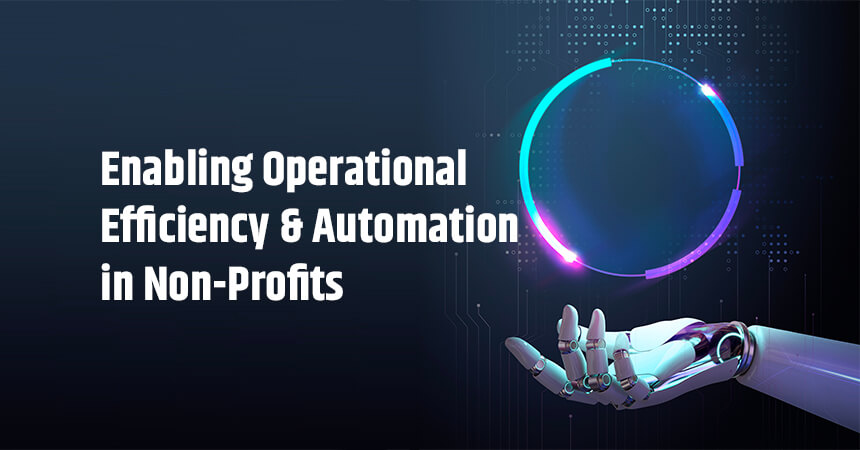Technology can be a fantastic tool to further social change. It can help non-profits increase productivity, improve effectiveness through better collaboration, and prolong services to new societies in need. Technology can also change how a non-profit, or a whole sector of non-profits, fulfills its purpose and effects a lasting impact in its communities.
IT is a vital investment and critical business enabler, not just infrastructure or operating costs. Yet several non-profits still grapple with viewing technology as a crucial investment.
Purposeful IT planning is crucial to ensuring that a non-profit can adopt the most aligned IT solutions and realize its value and social return.
Innovative application of technology can change the entire sector of non-profits by dramatically modifying how they do business, resulting in extremely efficient and scalable organizations.
In this world of highly restrained resources, how can you improve your impact and guard your non-profit’s future? You cannot do much without transforming the way you work. Since the current investment levels for attaining the global Development Goals rest flat, the only delta is productivity. Suppose your business can bring a step-change in productivity. In that case, you will be able to succeed over the resource gap, increase your impact, and achieve your mission.

Here is a look at some significant emerging but fast-maturing technologies that non-profits worldwide can use to improve their operational efficiency & Automation:

Data Analytics
Many non-profits in the world still handle most or all their business using paper records. It is a significant barrier for various reasons, including slow document processing and a shortage of real-time insights. Inducing technology helps digitize their records, consolidate multi-department organizations, and overlay AI to get a lot more done in the time they have.
Digitizing records and implementing analytics to identify and fix mistakes in paperwork, and matching applicants with relevant job opportunities, help them process more cases.

Blockchain
Requesting donations is possibly the most significant practical obstacle for non-profits pursuing success and change in the world. The problem involves the tricky process of money switching hands, sometimes over vast distances, and relying on third parties to confirm the transaction’s authenticity. It all sums up to a time-intensive and costly process.
Blockchain technology enables quick and secure soliciting of donations from across the world using its ledger. It saves non-profits substantial time and money spent on currency exchange charges and other costs.

Cloud Solutions
Non-profit organizations could significantly profit from cloud solutions. Most organizations are currently only using everyday tasks like email. Suppose they were to try cloud-based accounting, administration, and fundraising solutions. In that case, they would be able to reduce their operational expenses in the longer run. Transit to the cloud becomes even more significant when we think about the pervasive nature of mobile devices.
By shifting to complete Cloud-based systems, you can effortlessly store data, access shared data, collaborate, and stay in touch with team members.

Social Media
Using different social platforms to advertise your message, communicate with like-minded people, and educating them on your cause is imperative for non-profits.
Thus, non-profits that are adopting social media platforms are more prone to be noticed. Because of the unbelievable statistics, online distinctness through social media is a trend that will be prevalent for years to come.

Robotic Process Automation
RPA enables the supervision of fundraising campaigns. This process requires pulling past donor data in several organizations, creating marketing materials, communicating with past and new donors, handling donor payment data, entering it into accounting software, and vital financial information.
Most of these actions are performed manually, slowing down the process and presenting the chance of error. With an RPA, most of these processes are automated, enabling the organization to use more time interfacing with donors and acting on other mission-critical tasks.

CRM
Like any other business, NPOs have their distinct audience consisting of volunteers, partners, donors, members, and other supporters. The number of members is continuously changing. If you keep all data on paper, it becomes challenging to find data and monitor constituents’ interactions.
A CRM helps you to monitor relationships with every benefactor. It is more than just a contacts database. It enables you to trace all communications and campaigns, allot managers to projects, gather data about donors’ interests, and perform many other functions without manual intervention.
Closing Thoughts
Not-for-profit organizations continue to encounter a challenging landscape. Administrators and audit committees must deal with affairs ranging from drawing and engaging donors and grants, managing operational goals, and ensuring compliance with regulative requirements.
One thing often ignored by many not-for-profits is the influence that technology can have on their success. The use of new technology and its application must be a priority for organizations.
A passion for doing good drives non-profits. And a completely digital approach that aligns technology with a purpose can enable your people to deliver a more significant impact than ever before.
Your non-profit’s success in this digital-first world will mainly depend on your capability to improve productivity, innovate, and sustain high levels of trust and transparency. The only way to get there is to adopt digital transformation and develop a strategy that will drive your non-profit into the future.




